80 F. high in the Twin Cities Tuesday.
81 F. average high on August 12.
80 F. high on August 12, 2013.
August 12, 1964: A taste of fall over area with 26 in Bigfork and 30 in Campbell.
50-degree dew points today, near 70F by the weekend (meaning twice as much water in the air).
"...
We
don't read and write poetry because it's cute. We read and write poetry
because we are members of the human race. And the human race is filled
with passion. And medicine, law, business, engineering, these are noble
pursuits and necessary to sustain life. But poetry, beauty, romance,
love, these are what we stay alive for..." - Robin Williams, as John Keating in Dead Poet Society. Source:
IMDb.
Hint of Dog Days
"Ah,
summer, what power you have to make us suffer and like it" said Russell
Baker. Except for a Bangladesh-like June and a few severe wind episodes
there hasn't been all that much suffering this summer.
I still
don't see anything resembling an old-fashioned heat wave but, with high
confidence, I can predict that neighbors and complete strangers will be
griping about drippy dew points within a few days - forecast to hold
near 70F from Saturday into most of next week.
That's one of the
trends we're tracking: summers aren't appreciably hotter on average in
Minnesota (the real warming signal is showing up in winter, especially
at night), but dew points are running consistently higher. Warmer air
can hold more water vapor, meaning higher humidity levels; more moisture
available to spark extreme rain events.
The heaviest T-storms
should track south of Minnesota into the weekend; a relatively dry spell
with temperatures in the 80s - even a shot at 90F next week. More like
mid-July.
In today's weather blog: America's low-orbiting weather
satellites may be in trouble. And new research confirms an uptick in
extreme weather; odd jet stream gyrations that cause the weather to
become "stuck".
A Minor Case of the Dog Days.
Soak up the low dew points, because it'll feel like early July again by
late week, with tropical air lingering into next week. Highs will reach
the mid-80s, and I could see a 90F or two next week. The arrival of
this steamy warm front sets off isolated T-showers Friday into Sunday, a
better chance of T-storms by the middle of next week.
Super Soakers Push Across New England.
The same front that flooded much of Detroit and Baltimore will push
heavy T-storms across New England today, enough rain for flash flooding
in some communities. Monsoonal T-storms pop up from near Phoenix to Salt
Lake City, a few random storms flaring up over the Pacific Northwest.
60-hour WRF Future Radar courtesy of NOAA and HAMweather.
More Like June.
By August the atmosphere should be stabilizing with fewer thunderstorms
capable of severe weather and flash flooding. Tell that to residents of
the Northeast, where some 2-5" rains are possible again today. Dry
weather dominates over the central USA, locally heavy rain over the
Rockies from late afternoon instabilty T-storms. 60-hour WRF rainfall
totals: NOAA and HAMweather.
"Unprecedented" Flooding Event in Detroit Fits Global Warming Pattern. Meteorologist Andrew Freedman has the story at
Mashable; here's an excerpt that caught my eye: "...
Paul
Gross, chief meteorologist for WDIV-TV in Detroit, that the event was
absolutely unprecedented in his long career in the city.
I
have lived my entire life and worked my entire career here, and I have
never seen as widespread a flooding event. Yes, I vividly remember the
May 2004 historic month of rain — our second wettest month ever with
8.46 inches of rain — but that was a bunch of rainy days that really
added up.
I also remember some individual intense thunderstorms
that flooded ONE freeway. But I don't ever remember EVERY freeway being
flooded out.
The storm, which is likely to have
caused tens of millions in damage to a city that is already struggling
economically, is an example of the type of event that is already
occurring more frequently and severely due to manmade global warming..."
Photo credit above: "
Cars are stranded along a flooded stretch of Interstate 75 in Hazel Park, Mich., Tuesday, August 12, 2014." Image: Carlos Osorio/Associated Press.
* Live-blogging severe flash flooding in the Detroit area, courtesy of
The Detroit Free Press.
* Drivers swim to safety at I-696 and I-75 in metro Detroit. Details at
WXYZ-TV.
Extreme Weather Becoming More Common, Study Says.
Details of the new paper are below (in the climate story section), but
it shows the possible link between large-scale, long-term climate shifts
and day to day weather. So far there is correlation, but no causation,
no final smoking gun proving the link. Here's an excerpt from
The Guardian: "..
Climate
scientists in Germany noticed that since 2000 there have been an
“exceptional number of summer weather extremes, some causing massive
damage to society”. So they examined the huge meanders in the high-level
jet stream winds that dominate the weather at mid-latitudes, by
analysing 35 years of wind data amassed from satellites, ships, weather
stations and meteorological balloons. They found that blocking patterns,
which occur when these meanders slow down, have happened far more
frequently. “Since 2000, we have seen a cluster of these events. When
these high-altitude waves become quasi-stationary, then we see more
extreme weather at the surface,” said Dr Dim Coumou, at the Potsdam
Institute for Climate Impact Research. “It is especially noticeable for
heat extremes...”
Extreme Summer Heat, Rain On Rise As Weather Gets Trapped - Study. Picking up on the new research released Monday here's a slightly different perspective from
Reuters: "...
We
are warming our atmosphere by emitting carbon dioxide from fossil
fuels, but the increase in devastating heatwaves in regions like Europe
or the U.S. seems disproportionate," lead author Dim Coumou said in a
statement. Climate change was disrupting the flow of the jet stream,
which blows from west to east around the Earth and forms waves high in
the atmosphere that can be thousands of km (miles) from crest to crest.
"In periods with extreme weather, some of these waves become virtually
stalled and greatly amplified," it said. "While a few days have little
impact, effects on people and ecosystems can be severe when these
periods are prolonged..."
California Drought: San Francisco Poised To Require Water Rationing.
SFGate has the story - here's the introduction: "
San
Francisco water users would be forced to reduce outdoor watering by 10
percent - or face penalties - under a proposal by utility officials who
are poised to add the city to a growing number of California communities
that are rationing water amid one the worst droughts in decades....It
would apply primarily to large customers who use the bulk of their water
outdoors, like schools, golf courses, shopping centers and condo
complexes..." (File photo: AP Photo/Richard Vogel).
"Remarkable" Warming Reported in Central California Coastal Waters. Here's an excerpt from
The Los Angeles Times: "...
The
upper ocean within 50 to 100 miles of the coast has been 3.6 to about 7
degrees Fahrenheit warmer than what’s typical for this time of year,
mostly south of the Golden Gate, he said. “Scientists and many others
that are interested in our ocean are paying close attention to this
warming because it will likely impact marine life, and it could impact
marine life beyond this summer,” he said..."
Map credit above: "
Satellite images show the warming reported off the Central California coast during the first three weeks of July." (National Oceanic and Atmospheric Administration).
Sweden's Massive Forest Fire Lit By Record Temperatures.
Nature World News has more details on the highly unusual wildfire impacting Sweden; here's a clip: "...
As
of August 7, the fire was deemed a national emergency, and the Swedish
Armed Forces was mobilized to aid firefighters and help facilitate an
orderly evacuation of affected and threatened areas. A fire of this size
is extremely uncommon in Sweden, which traditionally experiences fores
fires that encompass a few square miles at most, according to the International Forest Fire News. In
fact, fires are so rare in the region that the Swedish movement
actually prescribes controlled burning of old and dried brush to promote
healthier woods..."
Photo credit above: "
A
massive forest fire in Sweden has been raging for 11 days, and has grown
into the largest fire the country has seen within the last four
decades. This fire is occurring in the wake of the highest temperatures
Sweden has ever experienced on record, and experts are quick to point
out that this is no coincidence." (Photo : USDA)
The Legacy of Florida's Year of Four Hurricanes.
The Orlando Sentinel has a good recap of a very crazy year: 2004. Here's a clip: "
For
six weeks, Florida reeled under the assault of four hurricanes. First
Charley struck Port Charlotte Aug. 13, 2004, with 150-mph winds. It
blasted its way into Central Florida five hours later with winds clocked
at 105 mph at Orlando International Airport. Hurricane Frances followed
on Sept. 5 with lashing winds and drenching rains that would total 14
inches in metro Orlando.
Tree limbs tore down power lines. Roofs were peeled from homes.
Thousands sweltered without electricity. Then Ivan came ashore near
Pensacola with 120-mile-per-hour winds and a storm surge that swamped
coastal towns. And Jeanne struck the same area as Frances on Sept. 25,
adding insult to injury..."
Hurricane Ivan file photo courtesy of NASA.
America's Weather-Tracking Satellites Are In Trouble. It's the low-earth satellites that are triggering the greatest concern; here's an excerpt of a good overview from
Popular Mechanics: "...
Those
polar-orbiting satellites, a primary and its backup, are the ones in
crisis. The primary satellite—a short-term pathfinder built to test
emerging technologies—was never really intended for use. Its backup
isn't much better: an aging satellite with failing sensors that passed
its predicted life expectancy last year. We would send up a replacement
now, but it's still being built. When it is ready, should it survive
launch, it could take until as late as 2018 to transmit usable data.
Which means that, depending on when our current satellites stop working,
the U.S. could be without crucial data for years. That's worse than
inconvenient. It could cost us trillions of dollars, and hundreds, if
not thousands, of lives..."
* 75 year anniversary of
The Wizard of Oz. How did film makers simulate a tornado? Think socks. KCTV in Kansas City has an
interesting article with more details.
"Massive Florida Red Tide" Is Now 90 Miles Long and 60 Miles Wide. C'mon kids - let's go swim in the red ocean! What is going on off the southwest coast of Florida? Here's an excerpt from
The Los Angeles Times: "
There's
a massive red tide blooming off the coast of southwestern Florida and
it appears to be growing. The red tide is patchy, but researchers say it
stretches an amazing 60 miles wide and 90 miles long in the Gulf of
Mexico. Just a few weeks ago it was reported to be 50 miles wide and 80
miles long. Even at its new size it's not the most colossal bloom
recorded in this part of the world, but it is the biggest since 2005,
according to Hayley Rutger, a spokeswoman with Mote Marine Laboratory
and Aquarium..."
File photo credit above: "
A 2006
algae bloom creeps toward Little Gasparilla Island, Fla. Scientists say a
massive bloom in the Gulf of Mexico could reach the state's
southwestern coast this month." (Paul Schmidt / For The Times).
Can Weather Patterns Help Predict Disease Outbreaks? Here's an excerpt of an interesting story and video at
CNN: "
Scientists
and meteorologists are able to predict the weather - could they apply
the same technology to predicting epidemics like Ebola? Carlos Watson, co-founder and editor of OZY, appeared on "New Day"
Friday to discuss the efficacy of climate change data and technology,
and how it could prevent future outbreaks. Researchers have found that
there could be correlations between weather patterns and the development
of disease in a specific region..."
U.S. Capability To Respond To The Next Great Disaster.
As populations continue to grow, with more people living in
(vulnerable) regions near rivers and sea level, the potential for major
disasters continues to increase. Here's a story from a story pondering
hypotheticals at
The Brookings Institution: "..
But
as global populations grow, especially along the Asian littoral, and as
certain storms or large-scale weather patterns are perhaps intensified
or at least shifted by climate change we need to be ready for worse.
Superimposing the bands of devastation from some of the above on more
populated areas helps one see the realm of the plausible. What if the
Fukushima nuclear accident had affected reactors near Tokyo, with its
population of some 30 million? What if a future Typhoon Haiyan targets
Shanghai? What if a massive earthquake hit Karachi, Pakistan or sent a
tsunami into the heavily populated areas of coastal East Asia?..."
Map credit: "
Population density of Asia and the Asia-Pacific. Darker colors indicate more people." (NASA).
Is Sunscreen a Lifesaver or a Poison?
Or does it lull us into receiving far more sunshine than we really
should? Everything in moderation, right? Here's an excerpt of an
interesting story that had me running for shade at
FiveThirtyEight: "...
People
who are fair-skinned have higher skin cancer rates, and their
pigmentation matters more than where they live. What is less well
established, at least in the data, is whether sunscreen mitigates these
risks. The theory behind sunscreen is very sound. Sunscreen absorbs UV
light, blocking it from reaching the skin, and UV light exposure is
linked with cancer. In practice, however, the evidence on the
relationship between sunscreen use and skin cancer is more limited..."
How Weather and Climate Models Work - Or Why Meteorologists Learn Calculus.
Yes, I still have nightmares about Math 102, "Advanced Partial
Differential Equations". Nasty stuff (and I still can't balance my
checkbook). Here's an excerpt of a good explainer from Dan Satterfield
at AGU,
The American Geophysical Union: "
Numerical
weather models have come light years over the last 30 years, and
despite what you may think, they make it possible to make very accurate
weather forecasts for as much as 5-7 days into the future possible. Have
you ever wondered just how they work? It’s not something that you can
cover in a few paragraphs, but it is not all that hard to get a basic
understanding of how it’s done, and if you will give yourself 50 minutes
and pay attention, you will (I hope) find it very fascinating. You will
also not just see greek when you see an equation like this somewhere!..."
How To Cover The Robin Williams Story Responsibly.
Borrow a term and concept from physicians, the Hippocratic Oath:
"...but first, do no harm". I thought Al Tompkins brought up some very
good points in a recent article at
Poynter - here's an excerpt that caught my eye: "...
One
of the most common mistakes that journalists can make in covering
suicide is to advance the notion that one big thing caused someone to
take their life. Suicide is a complex response that usually involves
lots of factors including mental illness. In fact, suicide experts
estimate 90 percent of suicides have some connection to mental illness
and/or substance abuse. Both are treatable..."
"
The truth
is that depression has nothing to do with bravery or courage. It is a
monster that strips those traits away before it even gets warmed up. If
anything, Robin Williams' suicide is another reminder that all the
talent and humor in the world is no match for the power and darkness of
depression. The way I see it, if you can fight off depression for 63
years and make others laugh and feel good, you are one courageous dude...." - Dave Pell, author of
NextDraft.
Dealing With Depression. On Monday
SAVE
(suicide awareness - voices of education) had it's annual golf
tournament at the TPC Course in Blaine. Many of the golfers and sponsors
have had first-hand experience with the ravages of suicide, and were
there to support prevention efforts, finding new ways to get a critical
message out: mental health issues tend to be ignored until it's too
late. There are treatments and medications that can help people
struggling with depression. News of Robin Williams taking his life
struck like a thunderbolt, and it highlighted the reality: it doesn't
matter if you're rich or poor, famous or infamous - depression can
strike anyone. It's up to us to search for symptoms, be aware, and get
the people we care about the help they need - in time.
* more Americans now die of suicide than car accidents, according to the CDC and
New York Times.
"...
I’ve said it before,
and I’ll say it again; dismissing the concerns of a genuine depression
sufferer on the grounds that you’ve been miserable and got over it is
like dismissing the issues faced by someone who’s had to have their arm
amputated because you once had a paper cut and it didn’t bother you.
Depression is a genuine debilitating condition, and being in “a bit of a funk” isn’t..." - Dean Burnett at
The Guardian.
Hit The Reset Button On Your Brain.
Our businesses and friendships often require that we stay connected to
The Matrix, but our long-term mental health requires that we disconnect
and give our brains a break; so argues an important story and study
highlighted at
The New York Times; here's a clip: "...
Every
status update you read on Facebook, every tweet or text message you get
from a friend, is competing for resources in your brain with important
things like whether to put your savings in stocks or bonds, where you
left your passport or how best to reconcile with a close friend you just
had an argument with. If you want to be more productive and creative,
and to have more energy, the science dictates that you should partition
your day into project periods. Your social networking should be done
during a designated time, not as constant interruptions to your day..."
 Electric-Drive Paddleboard for Anglers? Gizmag
Electric-Drive Paddleboard for Anglers? Gizmag
had an article about some pretty cool retrofits for a paddleboard if
you're looking for new (quiet) ways to get that trophy lunker; here's a
clip: "
Always looking for a new excuse to run its electric jet drive
through the water, WaveJet has released a new board designed for
fishing. The Pau Hana Big EZ Angler is the jet-powered stand-up
paddleboard that provides stand-up fishermen with a new way to quietly
troll the local fishing hole..."
TODAY: Sunny and pleasant. Dew point: 55. Winds: NW 10. High: 82
WEDNESDAY NIGHT: Mostly clear, still comfortable. Low: 61
THURSDAY: Partly sunny, still dry. High: 83
FRIDAY: More clouds, stray T-shower. Wake-up: 64. High: 85
SATURDAY: Some sun, thunder risk. Dew point: 68. Wake-up: 66. High: 86
SUNDAY: Steamy sun, free sauna. Isolated late-day T-shower? Dew point: 70. Wake-up: 70. High: 85
MONDAY: Humid. Risk of T-storms. DP: 71. Wake-up: 69. High: 84
TUESDAY: Feels like mid-July. Hot sun. Wake-up: 70. High: 87
Climate Stories...
Arctic Methane Could Accelerate Climate Change. Unknown
unknowns. We like to think, as a species, that we know all the various
paths the future might take, but when it comes to climate and potential
tipping points...we don't know nearly as much as we think we know.
Here's a clip from
The Green Optimist: "...
Unfortunately,
climate change due to rising CO2 levels is generating a spiral effect, a
positive feedback loop, which could lead us to a dangerous situation.
Dr. Box colorfully notes that, if even a fraction of Arctic carbon is
released, we’re “f-bombed as a species.”
The problem is that warmer temperatures are increasing the temperatures
of ocean currents, as well as air currents, which is leading to melting
ice caps, permafrost, and the undesirable effects that these generate
in their own turn. For example, some theorize that the recent hole that
opened up in the Yamal Peninsula,
Northern Russia, could actually have been caused by a collapsed pingo,
that is, melted permafrost leaving a cavity, which caved in. It may also
have been accompanied by a release of natural gas, which is commonly
found in the area..."
Tom Skilling on Climate Change.
Chicago Tonight at WTTW-TV
has an interview with one of the best TV meteorologists on the planet,
Tom Skilling (and a great guy too). Here's an excerpt: "...
You know,
I’m often asked why scientists only focus on the negative aspects? If
you look at both human society and ecosystems, they’ve both adapted to
changes in the climate when the changes are little. The changes we’re
seeing now are occurring 10 times faster. A rapid change makes it
difficult for both ecosystems and human societies to adapt to it..."
Ebola and Climate Change: Are Humans Responsible for the Severity of the Current Outbreak? Alarmist hype? Maybe.
Newsweek has the story that attempts to connect the dots; here's a clip: "...
Humans
are the major driver of emerging diseases,” says Jonathan Epstein, an
epidemiologist at the non-profit EcoHealth Alliance who studies Ebola
and other infectious disease. “Things like agricultural expansion and
deforestation...and certainly travel and trade — these are things that
manipulate our environment and allow pathogens to get from animal hosts
to people and then travel around the world.” In a study published
in 2012, researchers asked national infectious disease experts in 30
different countries whether or not they thought climate change would
affect infectious disease patterns in their countries. The majority
agreed..."
Don't Believe The Hype. 5 Reasons To Be Pessimistic About Climate Change.
I have my moments of pessimism - can we, as a global society, really
get our arms around this problem in time, in a concerted, thoughtful way
that won't wreck the economy? This will be our Moon Shot and Manhattan
Project rolled into one for the 21st century. Here's an excerpt of a
more downbeat assessment at
The Week: "...
While
the EPA's new regulations on power plants are a welcome first step,
they are not carved in stone. The EPA will likely face numerous legal
and legislative challenges before
its rules are implemented. Meanwhile, climate change denial remains the
mainstay of a significant portion of one half of the American political
spectrum. Messaging aimed at muddying the waters — of both the science
of climate change and the political imperative in tackling it — has not
abated. As Slate's Will Oremus has reported,
deniers are now willing to acknowledge some aspects of the scientific
reality, but are quick to interject that the cure will be worse than the
disease..." (Photo credit: Leslie Berg).
Quasi-Resonant Circulation Regimes and Hemispheric Synchronization of Extreme Weather in Boreal Summer.
It's a long title for a fairly straightforward concept, a symptom of
rapid warming, especially at northern latitudes, which may be impacting
the wavelength of global Rossby waves, creating conditions more
favorable for an elongated (high amplitude) jet stream, one more prone
to extreme weather, severe heat and excessive rains. For several years
I've been wondering if it was my imagination, if we really were seeing
tangible evidence of a more amplified jet stream capable of more
frequent weather extremes over the Northern Hemisphere? Or was there
hard data - research, to back up these observations? Here's a summary of
a technical, but very important new paper from Coumou, Petoukhov,
Rahmstorf, Petri and Schellnhuber at
PNAS.org: "...
The
recent decade has seen an exceptional number of boreal summer weather
extremes, some causing massive damage to society. There is strong
scientific debate about the underlying causes of these events. We show
that high-amplitude, quasi-stationary Rossby waves, associated with
resonance circulation regimes, lead to persistent surface weather
conditions and therefore to midlatitude synchronization of extreme heat
and reainfall events. Since the onset of rapid Arctic amplification
around 2000, a cluster of resonance circulation regimes is observed
involving wave numbers 7 and 8. This has resulted in a statisticially
significant increase in the frequency of high-amplitude quasi-stationary
waves with these wave numbers. Our findings provide important insights
regarding the link between Arctic changes and midlatitude extremes..."



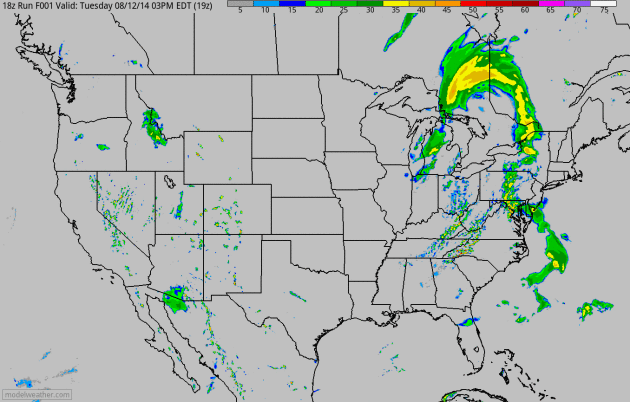
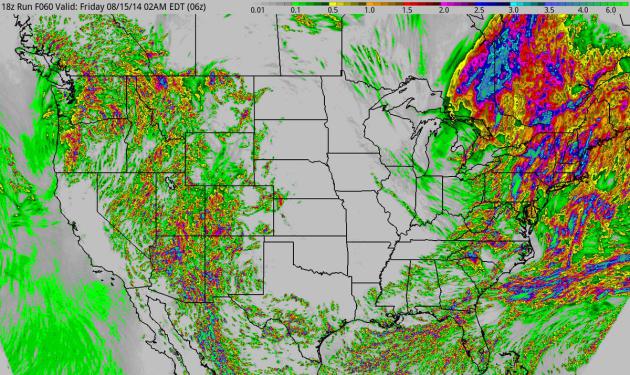


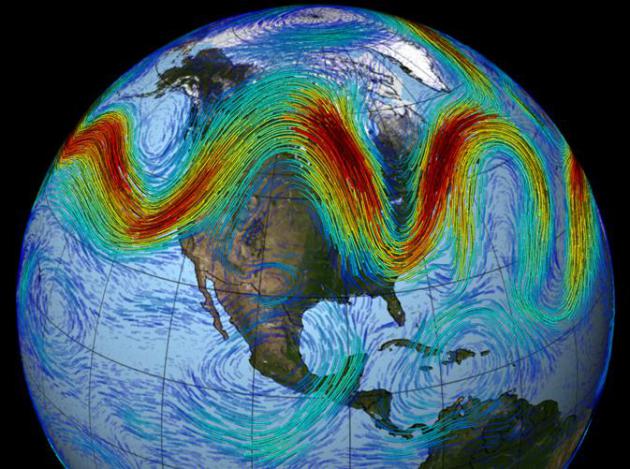

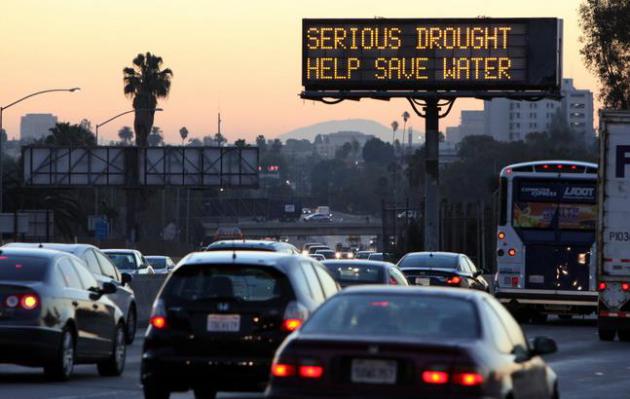

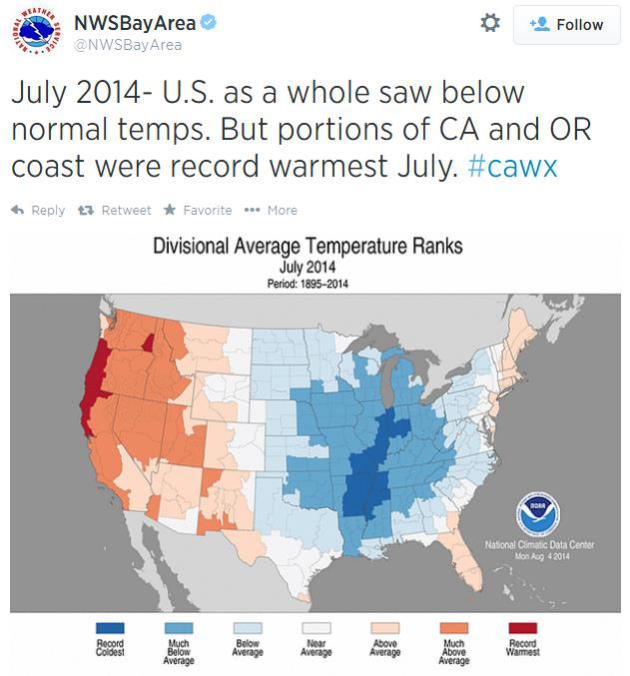
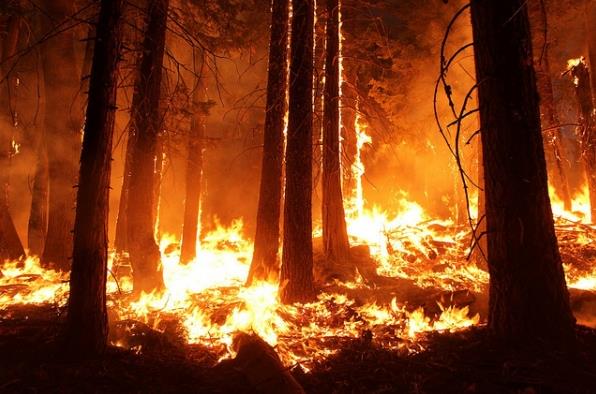
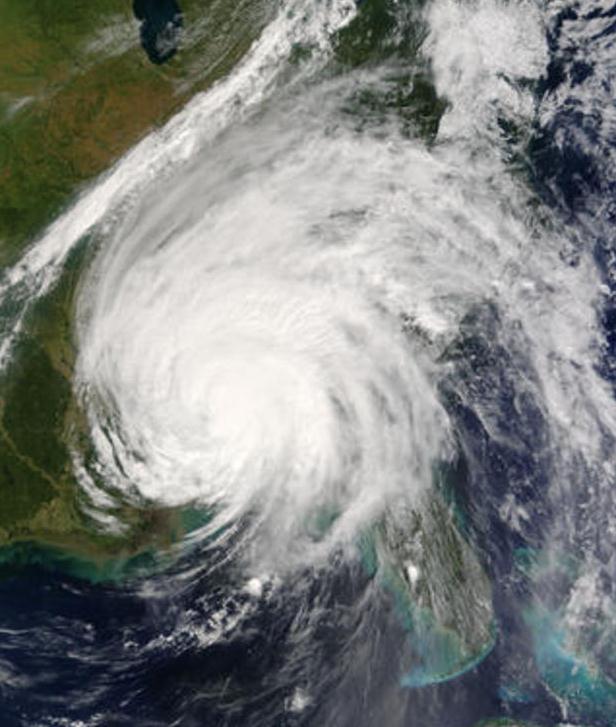
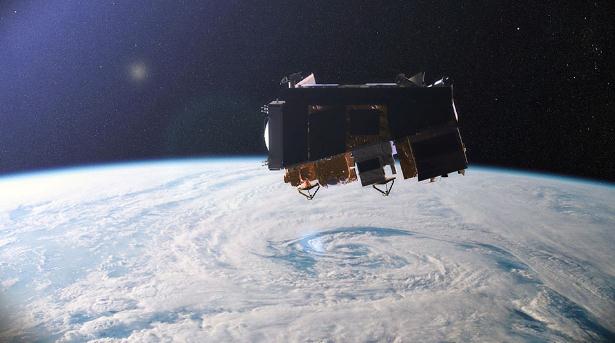
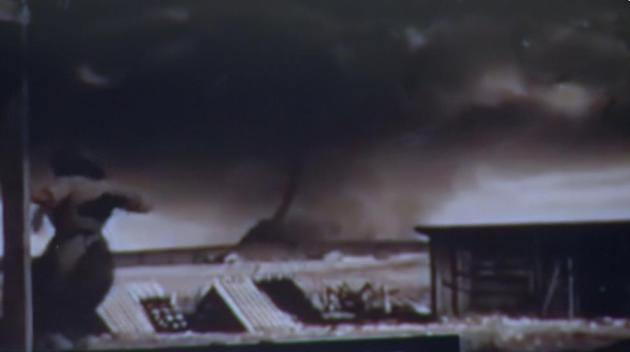
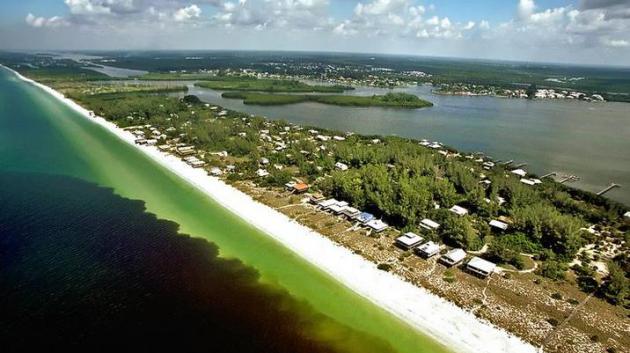








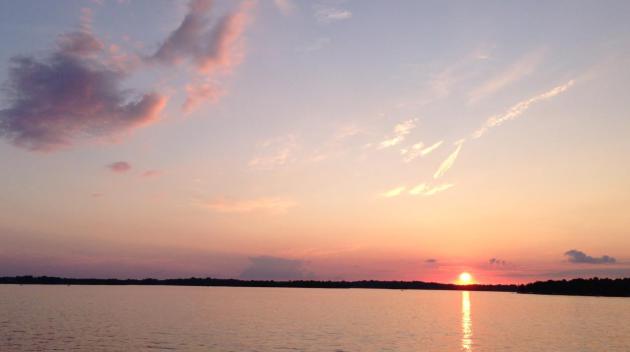
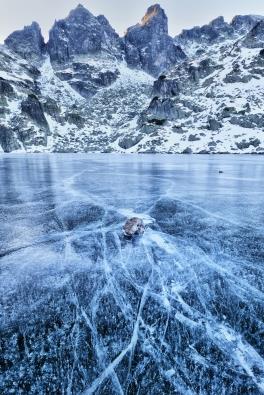


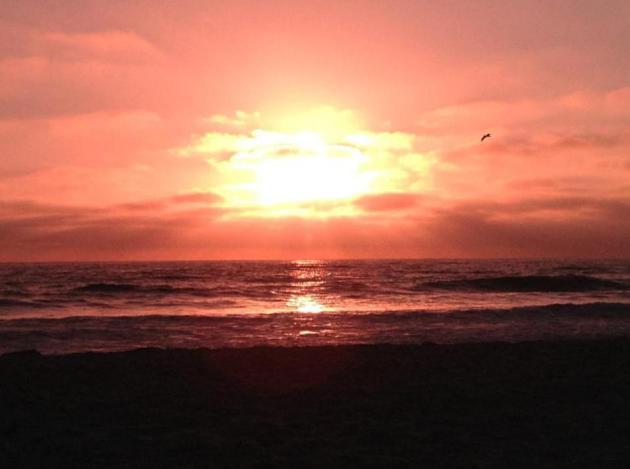
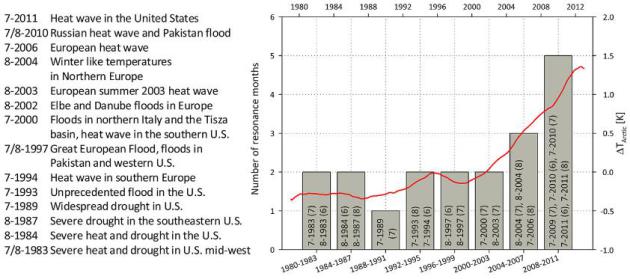
No comments:
Post a Comment